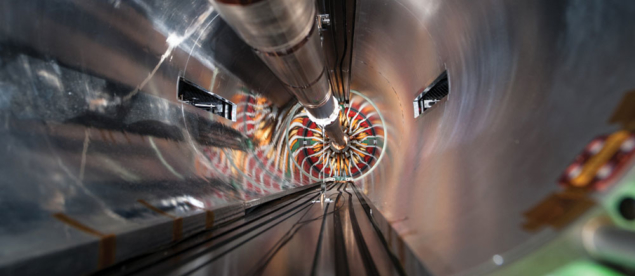
On 18 February the CMS and MoEDAL collaborations at CERN signed an agreement that will see a 6 m-long section of the CMS beam pipe cut into pieces and fed into a SQUID in the name of fundamental research. The 4 cm diameter beryllium tube – which was in place (right) from 2008 until its replacement by a new beampipe for LHC Run 2 in 2013 – is now under the proud ownership of MoEDAL spokesperson Jim Pinfold and colleagues, who will use it to search for the existence of magnetic monopoles.
Magnetic monopoles with multiple magnetic charge, if produced in high-energy particle collisions at the LHC, are so highly ionising that they could stop in the material surrounding the collision points and bind there with the beryllium nuclei of the beam pipe. To detect the trapped monopoles, Pinfold and coworkers will pass the beam-pipe material through superconducting loops and look for a non-decaying current using highly precise SQUID-based magnetometers.
Materials from the CDF and D0 detectors at the Tevatron and from the H1 detector at HERA were subjected to such searches during the 1990s, and the first pieces of beam pipe from the LHC experiments, taken from the CMS region, were tested in 2012. But these were from regions far from the collision point, whereas the new study will use material surrounding the CMS central-interaction region. “It’s the most directly exposed piece of material of the experiment that the monopoles encounter when produced and moving away from the collision point,” says Albert De Roeck of CMS and MoEDAL, who was involved in the previous LHC and HERA studies. “Although no signs of monopoles have shown up in data so far, this new study pushes the search for monopoles with magnetic charge well beyond the five Dirac charges currently achievable with the MoEDAL detector.”
MoEDAL technical coordinator Richard Soluk and a small team of technicians will first cut the beampipe into bite-sized pieces at a special facility constructed at the Centre for Particle Physics at the University of Alberta, Canada, where they have to be especially careful because beryllium is highly toxic. The resulting pieces, carefully enshrined in plastic, will then be shipped back to Europe to the SQUID Magnetometer Laboratory at ETH Zurich, where the freshly sliced beam pipe will undergo a short measurement campaign planned for early summer. “On the analysis front we have to estimate how many monopoles would have been trapped in the beam pipe during its deployment at CMS as a function of monopole mass, spin, magnetic charge, kinetic energy and production mechanism,” says Pinfold.
The latest search is complementary to general monopole searches that have already been carried out by the ATLAS and MoEDAL collaborations. Deployed at LHC Point 8, MoEDAL contains more than 100 m2 of nuclear-track detectors that are sensitive only to new physics and has a dedicated trapping detector consisting of around one tonne of aluminum.
“Most modern theories such as GUTs and string theory require the existence of monopoles,” says Pinfold. “The monopole is the most important particle not yet found.”
Further reading
J Pinfold 2019 Universe 5 47.
A de Roeck et al. 2012 Eur. Phys. J. C 72 2212.





